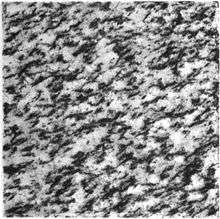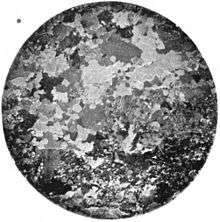Port Deposit Gneiss
| Port Deposit Gneiss Stratigraphic range: Paleozoic | |
|---|---|
 Polished slab of the Port Deposit Gneiss, about 10.7 cm wide | |
| Type | metamorphic |
| Lithology | |
| Primary | gneiss |
| Location | |
| Region | Piedmont of Maryland |
| Extent | eastern Maryland |
| Type section | |
| Named for | Port Deposit, Maryland |

Photomicrograph of Port Deposit Gneiss, approximately 0.85 cm across, under crossed polarized light.
The Port Deposit Gneiss is a Paleozoic gneiss formation in Harford County, Maryland. It is described as a "Moderately to strongly deformed intrusive complex, chiefly composed of quartz diorite gneiss. Rock types include gneissic biotite-quartz diorite, hornblende-biotite-quartz diorite, and biotite granodiorite, with minor amounts of quartz monzonite and hornblende-quartz diorite. Moderate protoclastic foliation grades into strong cataclastic shearing."[1] It intrudes into the Volcanic Complex of Cecil County.
Quarrying
The Port Deposit Gneiss has been quarried along the west bank of the Susquehanna River for over 100 years.
Port Deposit Gneiss was used in:[2]
- Many houses and five churches in Port Deposit
- Schools like the U.S. Naval Academy, Haverford College and The Catholic University of America
- Fort McHenry, Fort Delaware and Fort Carroll
- Public buildings like the Boston Public Library and the U.S. Treasury Building
- Public works like the Concord Point Lighthouse, Lincoln Tunnel and the St Augustine seawall
 McClanahan "Granite" Quarry c. 1898
McClanahan "Granite" Quarry c. 1898 McClenahan Quarry c. 1910.
McClenahan Quarry c. 1910.
References
- ↑ Geologic map of Harford County, Owens, James P., and Southwick, David L., 1968. Scale: 1:62,500. County Geologic Map CGM-1.
- ↑ A History of Maryland’s Lower Susquehanna Region
This article is issued from Wikipedia - version of the 5/3/2016. The text is available under the Creative Commons Attribution/Share Alike but additional terms may apply for the media files.